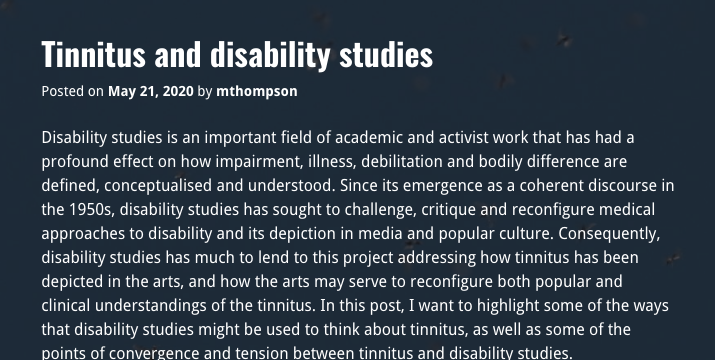Posteo este interesante artículo firmado por Dr Marie Thompson llamado «Tinnitus and disability studies» dentro del proyecto «Tinnitus, Auditory Knowledge and the Arts«.
Disability studies is an important field of academic and activist work that has had a profound effect on how impairment, illness, debilitation and bodily difference are defined, conceptualised and understood. Since its emergence as a coherent discourse in the 1950s, disability studies has sought to challenge, critique and reconfigure medical approaches to disability and its depiction in media and popular culture. Consequently, disability studies has much to lend to this project addressing how tinnitus has been depicted in the arts, and how the arts may serve to reconfigure both popular and clinical understandings of the tinnitus. In this post, I want to highlight some of the ways that disability studies might be used to think about tinnitus, as well as some of the points of convergence and tension between tinnitus and disability studies.
It might seem strange or even inappropriate to think of tinnitus in terms of disability. Tinnitus can be temporary, even momentary, and unobtrusive, having little impact on day to day life. Unlike other forms of disability, those with tinnitus are unlikely to become ‘spectacles of otherness’ in an ‘economy of visual difference’ (Thomson-Garland, 1997: 8). Tinnitus tends not to be associated with political marginalisation or social oppression; those who experience it are rarely considered a disadvantaged constituency or minority group (Roulstone et al, 2013). Yet tinnitus names a spectrum of auditory experiences. While it may be an infrequent niggle or minor inconvenience, tinnitus can be a debilitating and life-changing condition that impacts upon, disrupts and prohibits participation in social life. Indeed, a failure to acknowledge its debilitating effects have often been a source of frustration: as Mack Hagood argues: ‘like its phantom sound, tinnitus’s phantom social status vis-à-vis disability can be maddening to its sufferers’ (Hagood, 2017: 315). Furthermore, as with other illnesses, conditions and symptoms, the extent to which tinnitus is debilitating may vary not only between different listeners but also for the same listener at different points in their life. As Rosemarie Thomson-Garland notes, bodily impairments that make someone ‘disabled’ are rarely static or absolute; ‘they are dynamic, contingent conditions affected by many external factors and usually fluctuating over time.’ (1997, 13-14). Tinnitus and its effects may be amplified or abated by different living and working conditions, access to support networks, or in relation to other bodily conditions and impairments. Indeed, tinnitus is closely associated with various conditions that are more instinctively understood in terms of disability, including deafness, depression and head injury.
One of the central tenets of disability studies is that disability is not simply an individual or medical ‘problem’: it is also a social ‘problem’. (Roulstone et al, 2013). The social model of disability, which is associated with sociologist Mike Oliver and the British disability movement, figures disability as an externally imposed restriction: certain groups of people are disabled by social norms and attitudes, economic forces and environmental barriers. (Oliver, 2013; Shakespeare, 2010) Likewise, other social accounts have sought to emphasise that disability concerns the relation between a body, its impairment and society. Yet some critics suggest that social explanations of disability do not sufficiently address individual and subjective dimensions of disability; those embodied experiences that are irreducible to social constructions (Ellcessor et al, 2017). Susan Wendell, for example, questions the extent to which physical and/or mental suffering are inherent to bodily differences, ‘that is, how much suffering that could not be eliminated by any social arrangements, no matter how supportive they might be to the lives of people with disabilities?’ (Wendell, 1996)
As a highly individualised and frequently subjective condition, tinnitus could seem resistant to social understandings of disability: its affective qualities would appear to have little to do with the ‘social arrangements’ Wendell refers to. Yet tinnitus is not simply a ‘fact’ of the body and its mind. The conditions through which a listener develops tinnitus—through exposure to high volume sounds in the workplace or war, for example—can point to wider questions about the geopolitics of risk, debility and disposability. (Puar, 2017) Likewise, tinnitus may disrupt or be mediated by social (and socio-economic) ideals of productivity, self-discipline and auditory self control; or it may be antagonised by the auditory norms of shared social spaces: the loud music in bars or even silence in libraries, for example. Thus, while it is no means reducible to them, tinnitus is imbricated with social relations. Drawing on social understandings of disability, we might ask for whom and in what contexts does tinnitus as an auditory impairment become disabling; and how this might relate to particular social norms, values and ideals.
Disability studies’ critique of what Rosemarie Garland-Thomson describes as ‘the normate’– a idealised subject position that is ‘unmarked’ by disability, as well as race and gender; and which underpins liberal democratic notions of personhood – is also pertinent for a reassessment of tinnitus. It is in relation to the normate that disability becomes perceptible (and functions) as such. Again, this is not to deny the lived experience of impairment nor its affective qualities. Rather, the normate is what informs and is reproduced by the social relations that make particular impairments ‘disabling’. It is around the normate that workplaces, the media, medical institutions and educational institutions are organised; and to which ‘overcoming’ narratives about disability are often attached. Critical accounts of disability and its social origins tend to focus on the visible relationship of the normate and the disabled, made apparent by their representation in images, film and television. Tinnitus, and its debilitating effects, however, serve to highlight how the normate is also an auditory construct. The normate is ‘auraltypical’ or ‘otologically normal’: it underpins and is reproduced by, amongst other things, acoustic regulations and hearing technologies. It is the auditory norm against which tinnitus, alongside other hearing conditions and impairments, is judged as deviation.
To adopt a straightforward binary of normate/disabled, however, risks concealing its historical specificity: the complex relations between different types and modes of injury and impairment; and disability’s co-constitution with race, gender, class and sexuality. Indeed, discussions of disability—including hearing impairment—have often been Eurocentric, focusing on the global North. (Grech and Soldatic, 2016; Steingo, 2019) Similarly, research into tinnitus has often centred on Western Europe and the United States of America. Furthermore, as has already been noted, tinnitus refers to a spectrum of auditory experiences; and these have various causes and origins. In light of this, we might ask what is the relationship between the tinnitus that is ‘gained’ with aging and the tinnitus ‘gained’ through a violent encounter? To what extent are apparent truisms about tinnitus and its effects a product of a particular geopolitical standpoint? Despite its tendency towards Eurocentrism, disability studies can provide useful frameworks for addressing these questions, insofar as it has sought to address the co-constitutions of embodiment and the social; and the relationship between situated, lived experience and wider cultural, historical, economic and political formations.
Tinnitus and disability studies, then, have a potentially productive relationship. Disability studies can help to address tinnitus’s imbrication with social relations: while tinnitus is often understood as a highly subjective and individualised auditory experience, social understandings of disability can help to highlight the ways in which tinnitus and its effects are also products of history, culture and economy. In other words, disability studies can help to situate tinnitus within a wider social context. Tinnitus, likewise, can help draw attention to the auditory dimensions of the normate and the prioritisation of the ‘unmarked’ ear. Where disability studies has often focused on visual representations of disability, a critical consideration of tinnitus can help encourage further reflection on how invisible (and, in the case of tinnitus, inaudible) forms of impairment and injury are depicted.
References
Ellcessor, Elizabeth, Hagood, Mack, and Kirkpatrick, Bill. (2017) ‘Introduction: toward a disability media studies’. In Elizabeth Ellcessor and Bill Kirkpatrick, ed. Disability Media Studies. New York: New York University Press.
Garland-Thomson, Rosemarie (1997). Extraordinary Bodies: Figuring Physical Disability in American Culture and Literature. New York: Columbia University Press.
Grech, Shaun and Soldatic, Karen (2016) Disability in the Global South: The Critical Handbook. New York: Springer.
Hagood, Mack (2017). ‘Disability and biomediation: tinnitus as phantom disability’. In Elizabeth Ellcessor and Bill Kirkpatrick, ed. Disability Media Studies. New York: New York University Press.
Oliver, Mike (2013). ‘The social model of disability: 30 years on’. Disability and Society. Vol. 28/7, pp. 1024-1026.
Puar, Jasbir K. (2017). The Right to Main: Debility, Capacity and Disability. Durham: Duke University Press.
Roulstone, Alan, Thomas, Carol and Watson, Nick (2013). ‘The changing terrain of disability studies’ in The Routledge Handbook of Disability Studies. New York: Routledge.
Shakespeare, Tom (2010). ‘The social model of disability’. Available at: http://thedigitalcommons.org/docs/shakespeare_social-model-of-disability.pdf
Steingo, Gavin (2019). ‘Another resonance: Africa and the study of sound.’ In Gavin Steingo and Jim Sykes, ed. Remapping Sound Studies. Durham: Duke University Press.
Wendell, Susan (1996). The Rejected Body: Feminist Philosophical Reflections on Disability. New York: Routledge.





Leave a Reply
Lo siento, debes estar conectado para publicar un comentario.